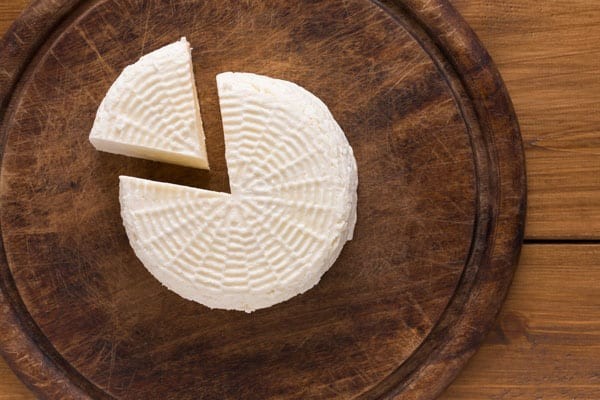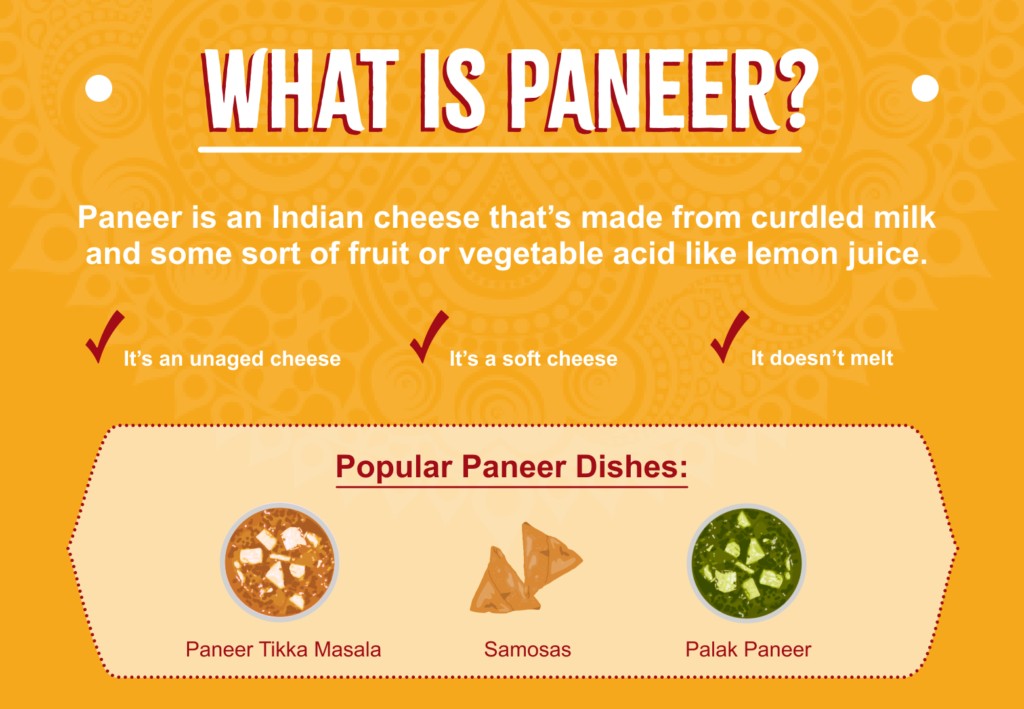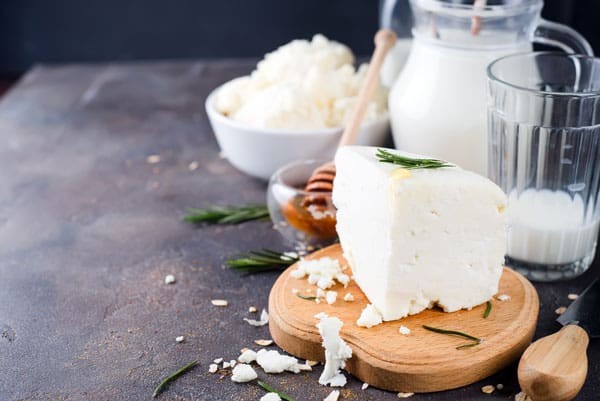Paneer Indian food, also known as Indian cheese, is a fresh, non-melting cheese popular in South Asian cuisine, and at FOODS.EDU.VN, we’re dedicated to providing you with all the culinary knowledge you need. Whether you’re curious about its origins, eager to try making it at home, or looking for delicious recipes, we have you covered with in-depth insights and expert tips. Learn about paneer nutrition, authentic Indian recipes, and different ways to make it.
1. Discovering Paneer: An Introduction to Indian Cheese
Paneer, a cornerstone of Indian vegetarian cuisine, is a fresh cheese made from curdled milk and a food acid, such as lemon juice or vinegar. Unlike many cheeses, paneer is non-aged and doesn’t melt, making it exceptionally versatile for cooking. Its mild flavor makes it a perfect canvas for absorbing the rich spices and flavors of Indian dishes. This makes paneer a fantastic source of protein, calcium, and essential nutrients, and an integral part of balanced diet.
1.1. Defining Characteristics of Paneer
Paneer is distinguished by several key attributes that set it apart from other cheeses:
- Freshness: It is a fresh, unaged cheese, meaning it’s consumed shortly after production.
- Soft Texture: Paneer has a soft, crumbly texture that is easy to cut and handle.
- Non-Melting: Due to its unique composition, paneer retains its shape when heated, making it ideal for grilling, frying, and adding to curries.
1.2. Culinary Versatility: From Snack to Main Course
Paneer’s mild flavor and firm texture make it incredibly versatile in the kitchen. It can be enjoyed in various ways:
- Snack: Cubes of paneer can be seasoned with spices and enjoyed as a protein-rich snack.
- Main Ingredient: Paneer stars in numerous Indian dishes, such as Paneer Tikka Masala, Palak Paneer, and Paneer Butter Masala.
- Breakfast: While less common, paneer can be incorporated into breakfast dishes like Paneer Bhurji (scrambled paneer).
1.3. The History and Origin of Paneer
The exact origins of paneer are debated, but the most widely accepted theory traces back to the 16th century in South Asia. It is believed that Persian and Afghan rulers introduced paneer to India. Regardless of its precise origin, paneer has become an integral part of Indian cuisine, enjoyed by vegetarians and non-vegetarians alike.
2. Making Paneer at Home: A Step-by-Step Guide
One of the joys of paneer is how easy it is to make at home. With just a few simple ingredients and minimal equipment, you can have fresh, homemade paneer in under an hour.
2.1. Essential Ingredients and Equipment
To make paneer at home, you’ll need:
- 8 cups of whole milk (full-fat milk is recommended for the best texture)
- 1/4 cup of lemon juice (or white vinegar)
- A large pot
- A colander
- Cheesecloth
- A heavy object (such as a pot filled with water)
2.2. Detailed Instructions for Homemade Paneer
Follow these simple steps to create your own fresh paneer:
- Prepare the Colander: Line a colander with a double layer of cheesecloth and set it in the sink. This will be used to strain the curds.
- Heat the Milk: Pour the milk into a large pot and bring it to a gentle boil over medium heat, stirring occasionally to prevent sticking.
- Add the Acid: Once the milk comes to a boil, reduce the heat to low and add the lemon juice (or vinegar). Stir gently. The milk will begin to curdle, separating into curds and whey.
- Strain the Curds: Remove the pot from the heat and pour the contents into the cheesecloth-lined colander. Rinse the curds with cold water to remove any residual acid and stop the cooking process.
- Squeeze Out Excess Liquid: Gather the edges of the cheesecloth and twist tightly to squeeze out as much liquid as possible. This step is crucial for achieving a firm texture.
- Shape and Press the Paneer: Tie the cheesecloth into a tight knot and hang it from a faucet or cabinet to allow any remaining liquid to drain for about 30 minutes. For a firmer paneer, place the cheesecloth bundle on a plate, top with another plate, and weigh it down with a heavy object (like a pot filled with water). Refrigerate for at least 20 minutes.
- Enjoy Your Homemade Paneer: Once chilled, remove the paneer from the cheesecloth and cut it into cubes or slices. It’s now ready to use in your favorite recipes.
2.3. Tips for Perfect Homemade Paneer
- Use High-Quality Milk: Whole milk yields the best results, providing a rich flavor and creamy texture.
- Don’t Overboil the Milk: Overboiling can result in a rubbery texture. Heat the milk gently and watch it closely.
- Adjust the Acid: The amount of lemon juice or vinegar may need to be adjusted depending on the milk. Start with the recommended amount and add more if the milk doesn’t curdle properly.
- Press for the Right Texture: The longer you press the paneer, the firmer it will become. Adjust the pressing time to achieve your desired texture.
For more in-depth instructions and delicious paneer recipes, visit FOODS.EDU.VN.
3. Where to Buy Paneer: Options for Every Cook
If you prefer not to make paneer at home, it’s readily available for purchase at various locations.
3.1. Local Indian Grocers
Your local Indian grocer is the most likely place to find a wide selection of paneer brands. These stores often carry fresh, high-quality paneer that is perfect for authentic Indian dishes.
3.2. Mainstream Grocery Stores
Many mainstream grocery stores now carry paneer in their refrigerated sections, often near the cheese or ethnic food aisles. While the selection may be limited, it’s a convenient option for those who don’t have an Indian grocer nearby.
3.3. Online Retailers
Online retailers like Amazon offer a variety of paneer options, from fresh to frozen. This is a great option for those who want to shop from the comfort of their own home or who live in areas where paneer is not readily available in stores.
3.4. Ready-to-Eat Paneer Dishes
If you want to skip the cooking altogether, consider purchasing ready-to-eat paneer dishes like Paneer Biryani. These convenient options provide a delicious and hassle-free way to enjoy paneer.
4. Paneer Substitutes: Options for Dietary Needs
If you can’t find paneer or are looking for vegan alternatives, several substitutes can be used in its place.
4.1. Mexican Queso Blanco or Queso Fresco
These Mexican cheeses are the closest in flavor and texture to paneer. They are also widely available, making them a convenient substitute.
4.2. Mild Feta Cheese
Feta cheese can be used as a substitute, but it has a saltier, more briny flavor. To reduce the saltiness, rinse the feta in water before using.
4.3. Extra-Firm Tofu
For a vegan option, extra-firm tofu is an excellent choice. Be sure to drain it well to remove excess moisture and press it to achieve a firmer texture. Tofu will absorb the flavors of the dish it’s cooked in, making it a versatile substitute.
4.4. Cottage Cheese
While not a direct substitute, cottage cheese can provide a similar creamy texture in some dishes.
5. Popular Paneer Dishes: A Culinary Journey
Paneer is a star ingredient in many popular Indian dishes. Here are some must-try recipes:
5.1. Paneer Tikka Masala
Paneer Tikka Masala is a creamy, tomato-based curry with grilled paneer cubes. It’s one of the most popular Indian dishes worldwide, known for its rich flavor and tender paneer.
5.2. Palak Paneer
Palak Paneer is a classic vegetarian dish made with spinach and paneer. The combination of earthy spinach and creamy paneer creates a delicious and nutritious meal.
5.3. Samosa
Samosas are savory pastries filled with spiced potatoes, peas, and sometimes paneer. These crispy, golden-brown treats are a popular snack and appetizer.
5.4. Paneer Biryani
Paneer Biryani is a fragrant rice dish made with paneer, vegetables, and aromatic spices. It’s a flavorful and satisfying meal that’s perfect for special occasions.
5.5. Paneer Butter Masala
Paneer Butter Masala is a rich and creamy curry made with paneer, tomatoes, butter, and a blend of aromatic spices. It’s a decadent dish that’s perfect for indulging in.
5.6. Kadai Paneer
Kadai Paneer is a semi-dry dish made with paneer, bell peppers, onions, and a special blend of spices called kadai masala. It’s a flavorful and vibrant dish that’s perfect for a quick and easy meal.
5.7. Dum Paneer
Dum Paneer is a slow-cooked dish made with paneer, yogurt, and a blend of aromatic spices. The slow cooking process allows the flavors to meld together, creating a rich and complex dish.
5.8. Paneer Bhurji
Paneer Bhurji is a scrambled paneer dish made with onions, tomatoes, and spices. It’s a quick and easy breakfast or brunch option that’s both flavorful and nutritious.
6. Health Benefits of Paneer
Paneer is not only delicious but also offers several health benefits.
6.1. Nutritional Profile of Paneer
Paneer is a good source of:
- Protein: Essential for building and repairing tissues.
- Calcium: Important for strong bones and teeth.
- Vitamin D: Helps the body absorb calcium.
- Phosphorus: Works with calcium to maintain bone health.
- Healthy Fats: Provides energy and supports hormone production.
The following table shows the nutritional value of 100 grams of Paneer:
| Nutrient | Amount (per 100g) |
|---|---|
| Energy | 260 kcal |
| Protein | 18.3 g |
| Fat | 20.8 g |
| Carbohydrates | 2.6 g |
| Calcium | 207 mg |
| Phosphorus | 138 mg |
| Vitamin D | 0.5 mcg |



6.2. How Paneer Fits into a Balanced Diet
Paneer can be a healthy addition to a balanced diet. It’s a good source of protein and calcium, making it a great option for vegetarians and those looking to increase their intake of these nutrients. However, paneer is also high in fat, so it’s important to consume it in moderation.
6.3. Potential Health Concerns
While paneer offers several health benefits, there are also some potential concerns to be aware of:
- High Fat Content: Paneer is relatively high in fat, which can be a concern for those watching their weight or cholesterol levels.
- Lactose Intolerance: Paneer contains lactose, which can cause digestive issues for those with lactose intolerance.
- Sodium Content: Some commercially produced paneer may contain high levels of sodium.
7. Advanced Paneer Techniques and Tips
For those looking to take their paneer game to the next level, here are some advanced techniques and tips.
7.1. Infusing Paneer with Flavors
Infuse paneer with herbs, spices, or marinades to add extra flavor. For example, marinating paneer in yogurt, ginger-garlic paste, and spices before grilling or frying can create a delicious and aromatic dish.
7.2. Grilling and Tandoori Paneer
Grilling or cooking paneer in a tandoor (a traditional Indian clay oven) gives it a smoky flavor and slightly charred texture. This technique is often used for Paneer Tikka and other grilled paneer dishes.
7.3. Freezing Paneer for Later Use
Paneer can be frozen for later use, but it may become slightly crumbly after thawing. To minimize this, wrap the paneer tightly in plastic wrap and then place it in a freezer bag.
8. Paneer Around the World: Regional Variations
While paneer is primarily associated with Indian cuisine, it has also found its way into other culinary traditions.
8.1. Paneer in South Asian Cuisine
In addition to India, paneer is also popular in other South Asian countries like Pakistan, Bangladesh, and Nepal. It’s used in similar dishes and preparations as in India.
8.2. Paneer in Western Cuisine
Paneer is increasingly being used in Western cuisine as a vegetarian alternative to meat. It can be found in dishes like salads, sandwiches, and wraps.
8.3. Fusion Dishes with Paneer
Chefs around the world are experimenting with paneer to create fusion dishes that blend Indian flavors with other culinary traditions. Examples include paneer tacos, paneer pizza, and paneer burgers.
9. The Future of Paneer: Trends and Innovations
The popularity of paneer is only expected to grow in the coming years.
9.1. Growing Popularity of Vegetarianism and Veganism
As more people adopt vegetarian and vegan diets, the demand for paneer and other plant-based protein sources is increasing.
9.2. Innovative Paneer Products
Food companies are developing innovative paneer products, such as flavored paneer, paneer spreads, and paneer-based snacks.
9.3. Sustainable Paneer Production
There is a growing focus on sustainable paneer production, with companies exploring ways to reduce the environmental impact of dairy farming.
10. FOODS.EDU.VN: Your Ultimate Resource for Paneer Knowledge
At FOODS.EDU.VN, we are committed to providing you with the most comprehensive and up-to-date information about paneer and other culinary topics.
10.1. Extensive Recipe Collection
We offer a vast collection of paneer recipes, from classic Indian dishes to innovative fusion creations. Whether you’re a beginner cook or an experienced chef, you’ll find something to inspire you.
10.2. Expert Tips and Techniques
Our team of culinary experts shares their tips and techniques for making perfect paneer every time. From choosing the right ingredients to mastering advanced cooking methods, we’ve got you covered.
10.3. Community Forum and Support
Join our community forum to connect with other paneer enthusiasts, share your recipes, and ask questions. Our team of experts is always on hand to provide support and guidance.
10.4. Stay Updated with the Latest Trends
We keep you updated with the latest trends and innovations in the world of paneer, from new products to sustainable production methods.
Are you eager to discover more culinary secrets and elevate your cooking skills? Visit FOODS.EDU.VN today to explore our extensive collection of recipes, expert tips, and in-depth articles. Unlock a world of flavor and become a culinary master with our comprehensive resources.
Contact us at 1946 Campus Dr, Hyde Park, NY 12538, United States. Call or WhatsApp us at +1 845-452-9600. Or visit our website: foods.edu.vn
FAQ: Answering Your Paneer Questions
Here are some frequently asked questions about paneer:
- What is paneer made of?
Paneer is made from fresh milk that is curdled using a food acid, such as lemon juice or vinegar. - Is paneer vegetarian?
Yes, paneer is a vegetarian cheese as it does not use rennet, an animal-derived enzyme, in its production. - How long does paneer last in the refrigerator?
Fresh paneer typically lasts for 2-3 days in the refrigerator. - Can I freeze paneer?
Yes, you can freeze paneer, but it may become slightly crumbly after thawing. - Is paneer healthy?
Paneer is a good source of protein and calcium, but it is also high in fat. It can be part of a balanced diet when consumed in moderation. - What is the best milk to use for making paneer?
Whole milk (full-fat milk) is recommended for making paneer as it yields the best texture. - Can I use vinegar instead of lemon juice to make paneer?
Yes, you can use white vinegar instead of lemon juice to curdle the milk. - How do I prevent paneer from becoming rubbery?
Avoid overboiling the milk and don’t add too much acid. Also, make sure to press the paneer properly to remove excess liquid. - What are some popular paneer dishes?
Some popular paneer dishes include Paneer Tikka Masala, Palak Paneer, and Paneer Butter Masala. - Where can I buy paneer?
You can buy paneer at Indian grocers, mainstream grocery stores, and online retailers.